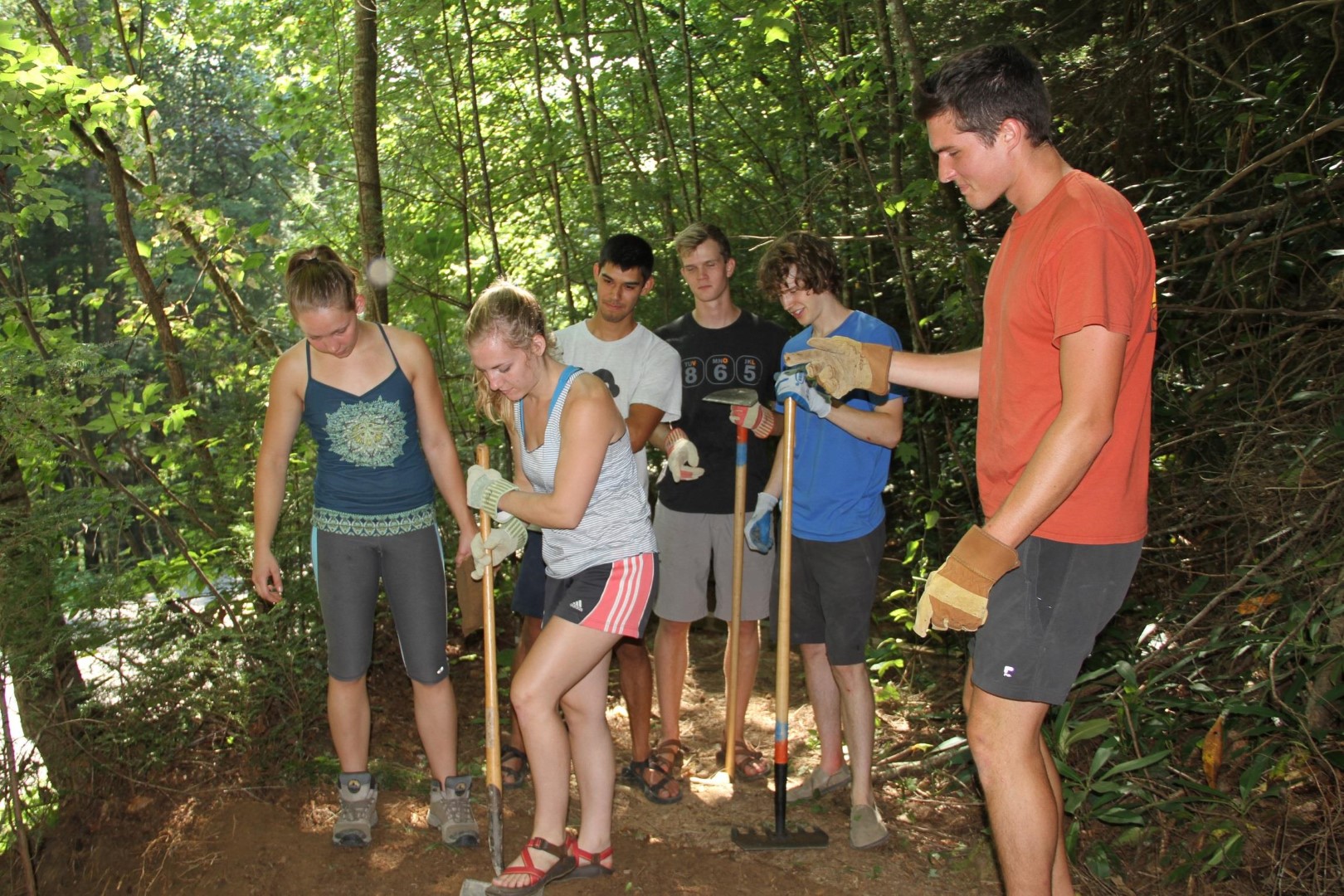News (799)
Children categories
ES! Initiatives (74)
EarthSolidarity!™ Initiatives are endeavors to which anyone can contribute in deed as well as in spirit, that
- minimize waste and environmental impacts
- increase community resilience
- respect and protect ecosystem processes and all forms of life
- contribute to good living conditions for everyone around the globe
- affirm and celebrate our interdependence and interrelatedness in the Web of Life!
Knoxville continues to foment a green industrial revolution
Written by Ben Pounds Spark CleanTech Accelerator participants join Knoxville Mayor Indya Kincannon during an Aug. 31 awards ceremony. Ben Pounds/Hellbender Press
Spark CleanTech Accelerator participants join Knoxville Mayor Indya Kincannon during an Aug. 31 awards ceremony. Ben Pounds/Hellbender Press
Knoxville celebrates sustainable technology startups from across the country
KNOXVILLE — Leaders of start-up green businesses specializing in services and products ranging from carbon reduction to cleaning products and piping wrapped up some warp-speed lessons Aug. 31.
At the conclusion of the three-month Spark CleanTech Accelerator the leaders of environmentally sustainable businesses from across the country took home some awards and got a strategic pep talk from Knoxville Mayor Indya Kincannon.
“I’m very committed to all things green and sustainable,” she said. “Orange and green are complementary colors." She spoke of making Knoxville a “clean tech hub,” not just for Tennessee but internationally. She envisioned “a cleaner Knoxville and a cleaner world.”
- spark clean tech acclerator
- University of Tennessee
- university of tennessee research park
- knoxville sustainability
- knoxville mayor sustainability
- indya kincannon
- ut research foundation
- frakktal
- groundstar
- tom rogers ut
- launch tennessee
- ben pounds journalist
- windfall
- 3d printing knoxville
- green llama
- raev
Smokies researchers make a formal acquaintance with a familiar salamander
 Jonathan Cox
Jonathan Cox
Great news from the Smokies via Instagram!
The “salamander capital of the world” just gained a new member! Meet our 31st species: the Cherokee black-bellied salamander, or Desmognathus gvnigeusgwotli. Its species name means “black belly” in the Cherokee language. Scientists used genetics to find out that it is different from the other black-bellied salamander in the park.
Last chance for comments in support of saving the country’s best remaining forests
 Old Growth U.S. National Park Service
Old Growth U.S. National Park Service
On July 14, the U.S. Department of Agriculture and U.S. Department of the Interior opened a public comment period following President Biden’s Executive Order to conserve mature and old-growth forests.
The deadline for comments is Tuesday, Aug. 30. Now is the time to protect our federally managed forests to safeguard our communities from the future impacts of climate change. Make your voice heard and submit a comment to the U.S. Forest Service and the Bureau of Land Management.
The mature and old-growth trees in our federally managed forests are one of this country’s greatest resources. These forests provide critical habitats for wildlife, prevent erosion and flooding, protect our drinking water, and are an essential climate solution.
United States forests cover about 290 million hectares of land and make up the fourth largest forest area of any country in the world. In 2019, the carbon sequestered in these forests offset approximately 12 percent of United States greenhouse gas emissions.
— Sierra Club
There’s a whole world in the dirt beneath your feet
Written by Tara Lohan The Dust Bowl of the 1930s resulted in the displacement of tons of soil in the midst of a drought similar to the one that grips the Southwest today. Library of Congress
The Dust Bowl of the 1930s resulted in the displacement of tons of soil in the midst of a drought similar to the one that grips the Southwest today. Library of CongressDirt is far from just dirt. It’s a foundation for life.
This story was originally published by The Revelator.
Look down. You may not see the soil beneath your feet as teeming with life, but it is.
Better scientific tools are helping us understand that dirt isn’t just dirt. Life in the soil includes microbes like bacteria and fungi; invertebrates such as earthworms and nematodes; plant roots; and even mammals like gophers and badgers who spend part of their time below ground.
It’s commonly said that a quarter of all the planet’s biodiversity lives in the soil, but that’s likely a vast understatement. Many species that reside there, particularly microorganisms such as viruses, bacteria, fungi and protists, aren’t yet known to science.
- the revelator
- soil type
- soil moisture
- why is soil important
- drought
- soil microbe
- biodiversity
- soil microorganism
- nutrient cycling
- reading university
- climate change
- soil degradation
- plastic pollution
- genetically modified organism
- pesticide
- artificial fertilizer
- land use change
- compaction
- erosion
- convention on biodiversity
- soil biodiversity observation network
- global soil biodiversity initiative
- ecosystem research
- multidimensionality
- macroecology
- farm to fork strategy
- microbial transplants
- soil quality
- soil sealing
Climbers can clean their crags during Obed event
 Volunteers are needed to improve and maintain climbing and approach areas at the Obed. National Park Service
Volunteers are needed to improve and maintain climbing and approach areas at the Obed. National Park Service
WARTBURG — The Obed Wild and Scenic River will host the park’s annual Adopt-a-Crag event on Saturday, Sept. 11 in cooperation with the East Tennessee Climbers Coalition.
Volunteers are needed to help with a variety of projects, including general trail maintenance and litter pickup. Participants should meet at the Lilly Pad Hopyard Brewery at 9 a.m. to register and receive a project assignment. Carpooling is suggested, and volunteers should bring their own lunch, water, hand tools and gloves.
When the work is done, volunteers are invited to spend the day climbing, kayaking or hiking. The ETCC plans a volunteer appreciation dinner that evening at the Lilly Pad.
For more information, contact the Obed Wild and Scenic River at (423) 346-6294.
Southeast Tennessee ridges and rivers will benefit from $10m infusion of federal natural resource funding
Written by Casey Phillips A crimper is attached to the back of a tractor on a farm in the Sequatchie River Valley. A relatively recent agricultural technique, crimping has been shown to reduce farmers’ input costs and improve soil quality. Recently, USDA approved funneling $10 million into a six-county region of Southeast Tennessee. This money will fuel conservation-minded improvements for landowners, including lowering the cost to rent equipment like crimpers and subsidize the planting of cover crops to improve soil health and reduce sedimentation in nearby streams. Tennessee Aquarium
A crimper is attached to the back of a tractor on a farm in the Sequatchie River Valley. A relatively recent agricultural technique, crimping has been shown to reduce farmers’ input costs and improve soil quality. Recently, USDA approved funneling $10 million into a six-county region of Southeast Tennessee. This money will fuel conservation-minded improvements for landowners, including lowering the cost to rent equipment like crimpers and subsidize the planting of cover crops to improve soil health and reduce sedimentation in nearby streams. Tennessee AquariumTargeted collaborative conservation will help local agricultural operations improve soil and water quality and protect aquatic life
CHATTANOOGA — Tennessee is as much a patchwork quilt of farms as it is an intricately woven lacework of streams and rivers. Soon, farmers and the aquatic life living alongside them will reap the benefits of $10 million in federal funds to support water-friendly agricultural improvements in the rolling uplands of the state’s southeastern corner.
The U.S. Department of Agriculture (USDA) approved the allocation of more than $197 million to support Regional Conservation Partnership Programs (RCPP) throughout the nation. These initiatives promote coordination between USDA’s Natural Resources Conservation Service (NRCS) and partnering organizations that are already engaged in conservation efforts.
- tennessee aquarium conservation institute
- tennessee aquarium
- tennessee department of environment and conservation
- farmland preservation
- land water preservation in se tennessee
- usda
- regional conservation partnership program
- ridge to river
- walden ridge
- sequatchie valley
- laurel dace
- natural resources conservation service
- chattanooga environment
- southeast tennessee environment
- tennessee endangered fish
- rcpp
Updated 8/23: Knox County Commission approves changes to “use-on-review” policy
Written by Wolf NaegeliKnox County Commission finalizes action to limit citizen rights to oppose developments.
KNOXVILLE — County Commission passed on second reading Monday an amendment to the county’s process for appealing Planning Commission decisions, according to Compass.
Hellbender’s initial story and updates follow:
“The revised measure passed on first reading with seven out of 11 votes, but Commission Chair Richie Beeler said his support was soft and he would need to be persuaded to vote for it a second time next month. If approved, the ordinance would give developers the option to have appeals of their plans heard by the BZA or in Chancery Court,” Compass reported.
Residents and developers who do not agree with a decision of the Knoxville-Knox County Planning Commission to permit or deny a land use that is somewhat unusual for their neighborhood can appeal to the city’s Board of Zoning Appeals (BZA). If their appeal is denied they may further appeal to the City Council, and as a last resort to the Circuit Court.
Knox County residents and developers, however, are not allowed to appeal to County Commission if the county BZA denies their appeal. For a second reconsideration, they must directly go to court, which tends to be prohibitively expensive for many.
Now County Mayor Jacobs and most county commissioners want to take away the option to appeal to the BZA for such projects outside the city limits, leaving the Circuit Court as the one and only way to have concerns reconsidered.
Skunked: Collapsing fisheries pose a dire threat to the planet
Written by Coty Perry A purse seine on a Chilean fishing vessel captures tons of mackerel. NOAA
A purse seine on a Chilean fishing vessel captures tons of mackerel. NOAA
We need to navigate to where fish sticks in your mind
You can read Coty Perry’s full report on overfishing at YourBassGuy.com.
When you hear about sustainability, one thing that often flies under the finder is the topic of overfishing. Many will say that overfishing is a natural response to the need for more fish, but it runs much deeper than that.
The goal of this article is not to shame any specific industry, country or company. The goal is to shine light on an issue I believe is highly under-reported by mainstream media.
SACE belays solar power on Global Climbing Day
Written by Thomas FraserMEMPHIS — Area residents were invited to a film screening of “Keep the Lights On” and a panel discussion at the Memphis Rox climbing gym with community members, local advocates and policy experts. The event, which ran from 10 a.m. to 4 p.m. Saturday, Aug. 20, coincided with Global Climbing Day, and professional rock climbers Nina Williams, Manoah Ainuu (who recently summited Everest), Olympic Silver Medalist Nathaniel Coleman, and Fred Campbell hosted and participated in community and climbing-oriented events prior to the film screening and conversation.
The film follows Memphis Rox staff member and leader Jarmond Johnson, recounting his experiences with intermittent energy access growing up in South Memphis, his growth into a gang activist and mentorship role at Rox, and, ultimately, working with professional rock climber and environmental activist Alex Honnold (best known for the academy award-winning film, Free Solo) to bring solar energy to the gym. Following the screening, Jarmond and a panel of experts discussed takeaways from the film, and how equitable access to solar energy could help all Memphians keep their lights on.
— Southern Alliance for Clean Energy
That ain’t country: Activists protest proposed downtown tree removal in Knoxville
Written by Thomas FraserKNOXVILLE — People assembled at 6 p.m. Aug. 19 to speak for the trees threatened by development of an art installment at the half-acre Cradle of Country Music Park at the corner of Gay Street and Summit Hill Drive downtown.
The Harvey Broome Chapter of the Sierra Club organized the protest against the removal of five mature oak trees to make way for the sculpture and its base, which was originally commissioned to a New York City artist in 2018 and will cost the city $600,000, according to reporting from Compass. The online news outlet also reported Friday that Councilwoman Seema Singh has requested a pause in the project to determine whether there are alternatives to removing the trees.
Coral, waste, water and weeds: Environmental vignettes from a UT journalism class
Written by Kaylee Walper, Mallory DeVore, Grace Ellison, Kathryn Kavanagh An empty Circle Park is seen in April. The park is adjacent to the UT School of Journalism and Electronic Media. Steven Bridges/University of Tennessee
An empty Circle Park is seen in April. The park is adjacent to the UT School of Journalism and Electronic Media. Steven Bridges/University of Tennessee
Everybody has a story about the natural environment. Look around, and into yourself.
University of Tennessee journalism professor Mark Littmann asks students in his environmental writing class every semester to write short sketches about environmental issues they may observe during any given day. Such an assignment requires an almost poetical approach. Here's a sampling from spring semester.
A reef of bones
Huge schools of rainbow-colored fish weave through the brightly colored corals as Sir David Attenborough describes a day in the life of a fish on the television screen. A little girl is mesmerized; this is no Disney fantasy but real life. The nature shows on Animal Planet capture her imagination and soon mornings and afternoons are spent watching big cats and meerkats navigate the wild spaces they call home. She finds an instant favorite in the book “The Rainbow Fish” and celebrates turning four with a sparkly rainbow fish cake, hand decorated with sprees for rainbow scales. She insists someday she will swim among the fish in their magical undersea world.
Activists urge TVA to take advantage of historic US climate bill for energy-efficiency improvements
Written by Dulce Torres Guzman A hopper car on a train filled with coal to be delivered to a TVA coal-fired plant. John Partipilo/Tennessee Lookout
A hopper car on a train filled with coal to be delivered to a TVA coal-fired plant. John Partipilo/Tennessee Lookout
Climate bill designates TVA as a potential recipient of clean energy investments and loans
This story was originally published by Tennessee Lookout.
KNOXVILLE — Clean-energy advocates are urging the Tennessee Valley Authority to use funds provided through the Inflation Reduction Act to deliver environmentally friendly energy to Tennessee customers.
The massive bill Congress passed Friday includes $370 billion for clean energy investments and listed TVA as an entity that is eligible to take advantage of clean energy credits and loans to significantly reduce the cost of energy-efficient infrastructure.
On Aug. 12, the Clean Up TVA Coalition, including the Sierra Club, the Southern Alliance for Clean Energy and Appalachian Voices, urged TVA to take advantage of the legislation and make funds available to its affiliated local power companies, which can then offer energy-efficient options for customers.
- tennessee clean energy
- tva fossil fuel
- tva clean energy
- us climate bill
- inflation reduction act
- tennessee lookout
- alternative energy
- alternative energy tva
- sierra club
- southern alliance for clean energy
- sace
- sace utilities report
- clean up tva coalition
- appalachian voices
- sunrise movement nashville
- utility energy efficiency
Parking fees set for Smokies; camping costs will increase
Written by Thomas Fraser
Smokies parking fees will generate $7 million in revenue for park infrastructure
GATLINBURG — Getting outside just got more expensive.
Great Smoky Mountains National Park officials announced Monday the park would proceed with plans for a $5/per day parking pass required of all cars staying in one spot for more than 15 minutes.
Weekly passes will be $15, and annual passes will be available for $40, according to a release from the park service. Fees will also increase $3 for backcountry and campground permits, meaning campers and backpackers will have to fork over $8 a night.
Monarch butterflies, an ephemeral but regular glimpse of beauty, are fluttering toward extinction
Written by Stephen Lyn Bales  A monarch butterfly, recently declared endangered despite decades of conservation, is seen atop a coneflower. Stephen Lyn Bales
A monarch butterfly, recently declared endangered despite decades of conservation, is seen atop a coneflower. Stephen Lyn Bales
Dramatic monarch declines mean the bell tolls for we
KNOXVILLE — Monarch butterflies are ephemeral by nature. The orange and black dalliances that flitter through our lives, our yards, and our countryside like motes of dust are here one minute and gone the next. We pause for a few seconds to watch the “flutter-bys” and then move on.
For about all of the Lepidopteran family, where they come from, where they go, their raison d'être, we don’t ask. They are winged wisps that pass through our busy lives. But that is not true with this orange and black butterfly, named to honor King William III of England, the Prince of Orange. But two people did ask.
Norah and Fred Urquhart lived in Southern Canada and in the late 1930s they noticed that the monarch butterflies seemed to all be fluttering south this time of the year. Could they possibly be migrating and if so, where did they go? The notion that a butterfly might migrate south for the winter seemed hard to fathom. Yes, broad-winged hawks migrate. But a flimsy butterfly?
- monarch butterfly
- monarch
- are monarchs endangered?
- stephen lyn bales
- stephen bales
- ijams nature center
- lepidoptera
- catalina aguado
- norah and fred urquhart
- flight of the butterflies
- xerces society
- great smoky mountains institute at tremont
- danaus plexippus ssp plexippus
- endangered species
- international union for conservation of nature
- pesticide
- pollinator
- habitat loss
- climate change
- herbicide
- mexico
At Gray Fossil Site, paleontologists let the bone-crushing dog out
Written by East Tennessee State University Illustration of the Gray Fossil Site bone-crushing dog, recently determined to have been active in the ancient Southern Appalachians. Mauricio Anton via ETSU
Illustration of the Gray Fossil Site bone-crushing dog, recently determined to have been active in the ancient Southern Appalachians. Mauricio Anton via ETSU
Discovery of ancient ambush predator is one of few large carnivores found at East Tennessee paleontological site
JOHNSON CITY — Overseen by the Don Sundquist Center of Excellence in Paleontology at East Tennessee State University, researchers have studied the Gray Fossil Site for over 20 years. They have identified many extinct animal and plant species of the Pliocene epoch that lived there some 5 million years ago. While large herbivores are well known from the site, large predators are relatively uncommon, so far including only alligators and scarce remains of at least one sabertooth cat.
Now, there’s a new predator on the scene.
A recent study published in the Journal of Paleontology describes a single right humerus (upper arm bone) of an animal named Borophagus, a member of an extinct group more commonly called bone-crushing dogs. The animal is so named for its powerful teeth and jaws. This is the first evidence of any animals in the dog family from the Gray Fossil Site.
The research was conducted by Emily Bōgner, a doctoral student at the University of California, Berkeley, and alumnus of ETSU’s paleontology master’s program, and Dr. Joshua Samuels, associate professor in the ETSU Department of Geosciences and curator at the Gray Fossil Site and Museum.
More...
SACE sees many silver linings in Senate climate bill; House passage expected
Written by Amy Rawe A rainbow pierces gray skies during the 2021 United Nations Climate Change Conference in Glasgow. United Nations
A rainbow pierces gray skies during the 2021 United Nations Climate Change Conference in Glasgow. United Nations
Climate activists stress positives of Senate climate bill despite its shortcomings
Amy Rawe is communications director for Knoxville-based Southern Alliance for Clean Energy.
KNOXVILLE — The U.S. Senate passed the Inflation Reduction Act (IRA), an estimated $430 billion bill, of which approximately $370 billion will be allocated to investments in clean energy and to address climate change.
It’s the single largest climate investment in U.S. history, and if it passes the House, will put the country on a path to be able to achieve roughly 40 percent emissions reduction from 2005 levels by 2030, reestablishing our influence in meeting the Paris Agreement goal of limiting global warming to 1.5 degrees Celsius.
- southern alliance for clean energy
- climate bill
- inflation reduction act
- alternative energy
- sace
- stephen smith
- solar power
- southeast climate change
- electric car
- electric cars in southeast
- senate climate change
- amy rawe
- wind power
- what's in climate change bill?
- carbon dioxide
- carbon dioxide ppm
- global climate change
- global climate change knoxville
Dems pass huge climate bill assailed by some as another fossil energy sop
Written by Airiana Figueroa and Jacob Fischler
Record-setting bill will fund extensive efforts to address climate change, but the sausage-making deal is decried by some as a ‘suicide pact’
This story was originally published by Tennessee Lookout.
WASHINGTON — The U.S. Senate, along party lines, passed a sweeping energy, health care, climate and tax package Sunday afternoon, following an overnight marathon of votes that resulted in just a handful of notable changes to the legislation.
The 755-page bill was passed after Vice President Kamala Harris broke a 50-50 tie in the evenly divided Senate. It now heads to the House, where Democratic leaders have announced they will take it up on Friday.
At last, we have arrived,” Senate Majority Leader Chuck Schumer said. Democratic senators broke out into applause as Harris announced passage of the bill, expected to total more than $700 billion.
Schumer, a New York Democrat, said he dedicated the measure to young Americans who have pushed and protested for the Senate to take action on climate change.
An under-appreciated Black scientist pioneered the modern study of bees and other insects
Written by Edward D. Melillo Zoologist Charles Henry Turner was the first scientist to prove certain insects could remember, learn and feel. Charles I. Abramson via The Conversation
Zoologist Charles Henry Turner was the first scientist to prove certain insects could remember, learn and feel. Charles I. Abramson via The Conversation
Charles Henry Turner concluded that bees can perceive time and develop new feeding habits in response
This story was originally published by The Conversation. Edward D. Melillo is a professor of history and environmental studies at Amherst College.
On a crisp autumn morning in 1908, an elegantly dressed African American man strode back and forth among the pin oaks, magnolias and silver maples of O’Fallon Park in St. Louis, Missouri. After placing a dozen dishes filled with strawberry jam atop several picnic tables, biologist Charles Henry Turner retreated to a nearby bench, notebook and pencil at the ready.
Following a midmorning break for tea and toast (topped with strawberry jam, of course), Turner returned to his outdoor experiment. At noon and again at dusk, he placed jam-filled dishes on the park tables. As he discovered, honeybees (Apis mellifera) were reliable breakfast, lunch and dinner visitors to the sugary buffet. After a few days, Turner stopped offering jam at midday and sunset, and presented the treats only at dawn. Initially, the bees continued appearing at all three times. Soon, however, they changed their arrival patterns, visiting the picnic tables only in the mornings.
Falling trees accountable for very few deaths in Smokies, but they do happen
CITIZEN TIMES: Child killed by falling tree was a very rare twist of horrible fate
Karen Chavez of the Asheville Citizen Times wrote a great article on tree-related deaths in Great Smoky Mountains National Park and beyond following the death last week of a Georgia child killed by a falling tree as she was occupying a tent in Elkmont Campground.
She reports the death of the child was only the 11th tree-linked death in the national park’s history.
